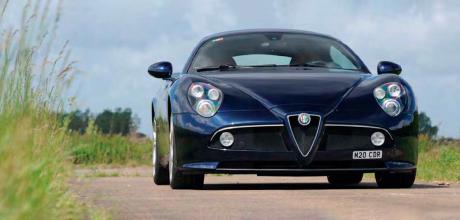2008 Alfa Romeo 8C Competizione Type 920
Rising values show that car collectors truly love the Alfa 8C Type 920. But will they be rewarded with a drive that matches the price tag? We find out in a one-of-one Ultramarine Blue example.
Story by Nathan Chadwick
Photography by Michael Ward
Alfa Romeo 8c Competizione: Beauty In The Beast
One-of-one paint scheme for Alfa’s GT star
If you spend your evenings scouring the internet classifieds – let’s face it, we all do it – and happen across the rare occasions when an 8C is offered for sale, you may notice a couple of things. They all tend to be low mileage, for one. They all tend to be virtually untouched, for another. Trinkets in a collection, barely moving in real life.
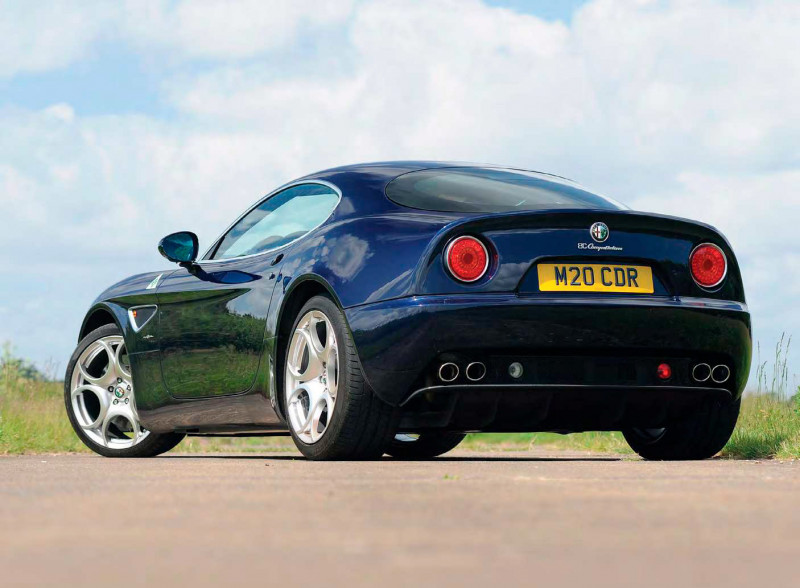
That seems a great shame, especially as I’ve just seen Clive Richardson’s superb Blu Oltremare (Ultramarine Blue) example rumbling into view. In the flesh, the 8C is much larger than you expect, but there’s no denying the impact – this is one good-looking car. There is not a crease out of shape, not one clumsily arranged line, no function-over-form hack-and-slash. Wolfgang Egger’s design changed very little from the 2003 8C concept car, which you can still see in the Alfa Romeo Museum in Arese.
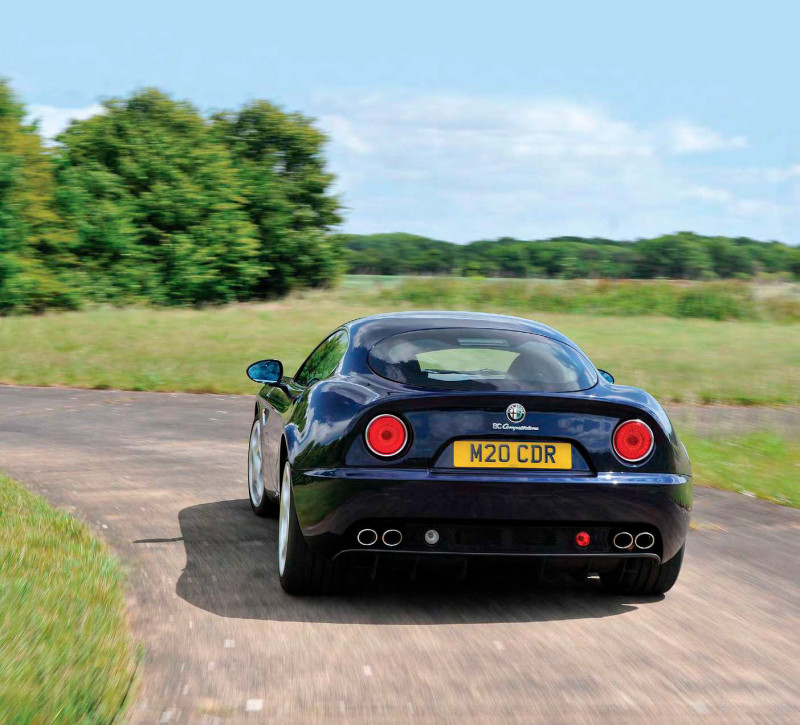
Then there’s the noise. Under the bonnet is a Maserati V8 4.7-litre F136 YC V8 engine. Introduced in 4.2-litre guise in the Maserati Coupe of 2001, the F136 engine ended up in the GranSport, Quattroporte and GranTurismo with cross-plane crankshafts, and in the Ferrari F430, California and 458 with flat-plane crankshafts. The Alfa 8C followed the Maserati route.
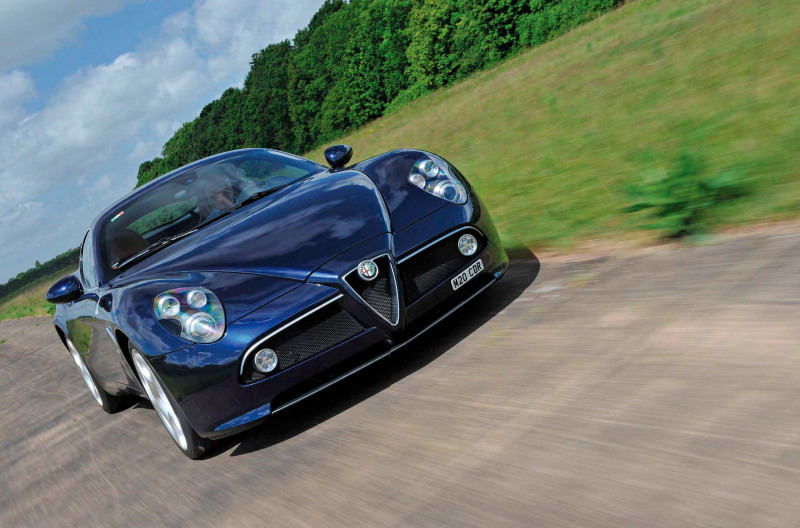
In fact, the 8C is pretty much a Maserati underneath, the Quattroporte being the most closely related model. Its central floor section has carbonfibre bonded on, while the 8C uses Maserati-specification double wishbones with dampers specifically tuned for the model; Maserati’s Skyhook adaptive damping was junked for a more analogue feel. The engine sits far back in the engine bay and the transaxle gearbox is forward of the rear differential, to localise the mass in the centre of the car.
Buoyed by the great response to the 8C concept at its 2003 Frankfurt Show reveal, Alfa Romeo wanted to build the car, but parent company Fiat was struggling for cash. Then in 2005, Antonio Baravalle became Alfa’s CEO, and luckily he was an avowed fan of the car, along with Maserati boss Karl- Heinz Kalbfell. Between them, they cooked up a plan to deliver a halo project at minimal cost. The flipside would be brutally slashing Alfa Romeo’s advertising budget. In fairness, in 2005 Alfa’s fleet was looking a little old hat – late-era remodels of the 156 and 166 were sticking plasters – so what better way to inject some new dynamism into the Alfa brand than a new supercar? The 8C Competizione got the green light.
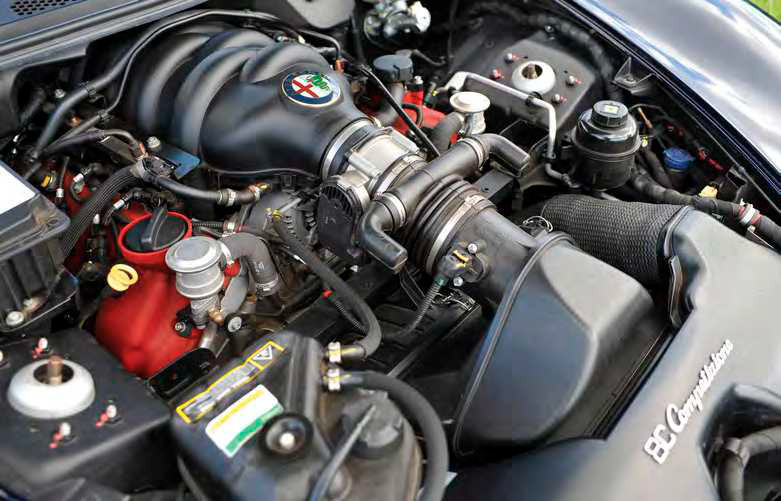
Just 500 would be made – all sold in no time, so a further 500 8C Spiders would be built. In the years since, conventional wisdom about Alfa Romeos depreciating has been turned on its head: I can recall seeing only one 8C sell below its original £110,000 list price and that was many years ago. You’re looking at between £230,000 and £250,000 to make an 8C yours these days.
That presents another query: given the Maserati underpinnings, is the driving experience manifestly different to a GranSport or GranTurismo? Strip away the styling, limited numbers and Alfa Romeo badge, could you save yourself £150,000 and get either a GranTursimo MC Stradale or GranSport MC Victory, and have an extra pair of seats into the bargain?
Such practical thoughts take a little while to seep into my mind, as my gob is currently grazing the tarmac – it really is very pretty, this, isn’t it? But enough of the gawping, let’s get touchy feely. It’s tight in the cabin – the 8C has a 10in shorter wheelbase than the Maserati GranTurismo, and is 20in shorter overall. You get just two seats and a small gap behind your head for light luggage, plus a tiny hole in the boot that Clive suggests is just enough for a couple of wine bottles.
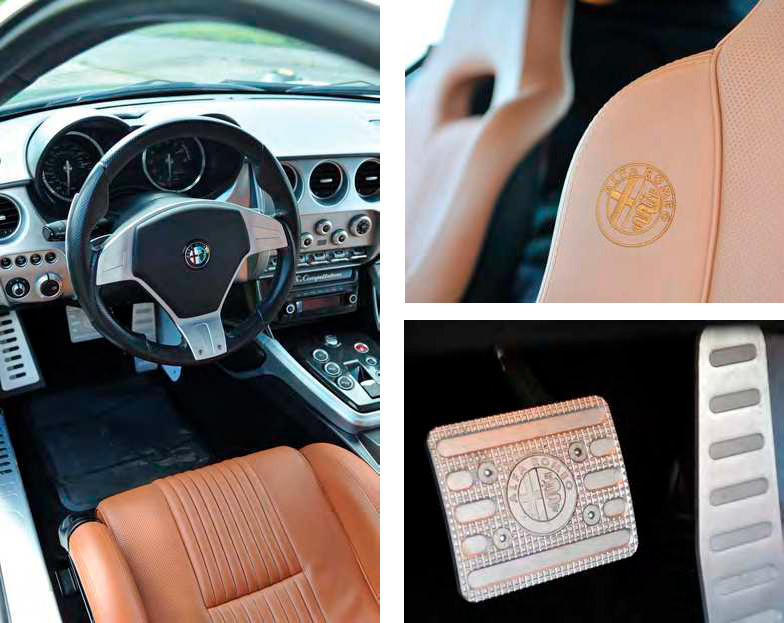
It’s hard not to be drunk on the 8C already. It feels special in here: the cold metal of the shift paddles, the gorgeous leather pews, the sheer immediacy of the environment. It might be a little cramped given the 8C’s exterior dimensions, but you do feel part of it all.
That feeling continues in motion. Anyone familiar with Maserati’s Cambiocorsa paddle-shift gearbox will immediately get to grips with the six-speeder here. It’s nowhere near as quick as modern dual-clutch gearboxes, and in purely objective terms it is indeed ‘worse’, but the 8C’s clunky single-clutch set-up has a proper mechanical feeling that requires some finesse to get just right. It’s clunky at low speed and in full automatic mode it’s more lurchy than the dents in The Addams Family’s hallway door frames. You quickly become in tune with the system, though. Each paddle pull unleashes another gruff, baritone snarl. It’s pure tailpipe theatre, with fuzzy crackle on the overrun, and a bassy war-cry as the engine sprints towards the its 7000rpm peak power point, when 450 horses are being hammered into the asphalt by a limited-slip differential-aided rear axle. 60mph is a memory after little more than four seconds and flat-out you’ll see 181mph. The 8C doles out 480Nm at 4750rpm, with 80 per cent of it available from half that, but it could do with more torque, considering the 8C’s role as more of a GT than a high-revving sports car.
In steering terms, you might be expecting an approximation of the GranTurismo MC Stradale, but the 8C’s feel is very different. It’s still a quick rack, but the weight is heavier, and there’s far more information about what’s going on through its 20in wheels than the somewhat aloof feeling of even the GranTurismo’s sportiest variant. This means the Alfa suddenly shakes off its ‘Maserati in Alfa clothing’ demeanour; it develops into an engaging, engrossing experience in the manner of the marque’s predecessors. Of course, it doesn’t corner with the razor-sharp accuracy of a Ferrari F430, but people let you out of junctions. How about that for real-world pace?
The 8C still feels engaging, exciting and visceral in a way that the GranTurismo only really manages in a straight line. Despite weighing 200kg less than the GranTurismo, the 8C still feels big, not helped by a fair degree of body roll when pushing on. Start to push on and the 8C provides a nibble of understeer to remind you of your own mortality, and a playful rear end if you push it further. However, it feels at its most comfortable on A-roads, with a slow-in, fast-out style. It might not be the last word in vehicle dynamics, but I get into the giggle zone more often than most supercars, more of the time.
It even rides fairly well. The 8C has been criticised for its ride quality, and although it’s noticeably firmer than a GranTurismo, it’s certainly not the filling-uprooter it’s purported to be – perhaps something to do with non-original compound tyres. Take the 8C on to choppy B-roads and the damping protests but this is a car that’s not really intended for B-road thrashes. Keep it to the smoother A-roads it was designed for, and you’re unlikely to feel what all the fuss is about.
There is plenty of fuss about the 8C, even in its discreet Blu Oltremare hue – apparently the only 8C to be so painted. People stop, stare and smile. It's a car with good vibes, this – from the way it drives to the reaction it receives. There are any number of ways to cover ground that are ultimately faster, but very few offer the same level of theatre, engagement and excitement, even if you roll up at 20mph. For Clive, it carries on a tradition for eight-cylinder Alfas, for his father owned an original 2300 8C – and a rather special one at that. Chassis 2111033 won the Mille Miglia with Campari behind the wheel in 1932, then again a year later with Nuvolari and yet again in 1934, this time with Varzi on driving duties. More recently, it has appeared on the Mille Miglia revival runs with Clive’s dad behind the wheel. It’s now moved to a United States collection, but Clive’s got a muchloved and much-enjoyed Montreal to keep the eight-cylinder Alfa theme going. The 8C Comp is a keeper, too, and Clive is considering taking it on a trip to the Alfa Romeo Museum at some point.
VERDICT
Many pundits have described the 8C as disappointing, but when you consider its ultimate aims, it pretty much nails its brief. It’s not perfect – the most loveable things rarely are – but they are forgivable, and not just because it’s Italian. Go in expecting a nimble sports car and you won’t find that. Instead you’ll find a very Italian take on the Aston Martin V8 Vantage. Both are achingly pretty, both have 4.7-litre V8s, and both put out a similar amount of power.
In objective terms, the 8C is expensive. It needs to feel special to justify its price tag. You know what, it does. The interior is far more special than the Aston’s, and the 8C’s steering is drastically better than the GranTurismo and GranSport. The 8C is left-hand drive only, but if ever you needed encouragement to travel Europe in style, this is it. The 8C might make little sense, but then the very best things never do.
Many thanks to Clive Richardson and the Alfa Romeo Owners Club
TECHNICAL SPECIFICATIONS ALFA ROMEO 8C COMPETIZIONE
- ENGINE: 4691cc V8 DOHC
- COMPRESSION RATIO: 11:3.1
- MAX POWER: 450hp at 7000rpm
- MAX TORQUE: 480Nm at 4750rpm
- TRANSMISSION: 6-speed semi-auto, RWD
- DIMENSIONS: 4381mm (L), 1894mm (W), 1341mm (H)
- WEIGHT: 1580kg
- MAX SPEED: 181mph
- 0-62MPH: 4.2sec
- PRICE NEW: £110,000
- VALUE NOW: £230,000-£250,000

Blu Oltremare paint is unique. Driving the 8C dispels most of the poorly formed ‘received wisdoms’


